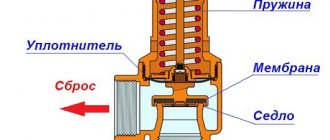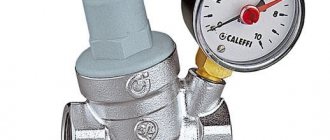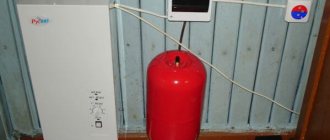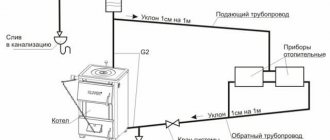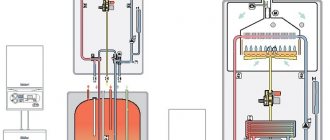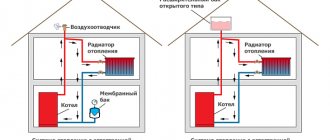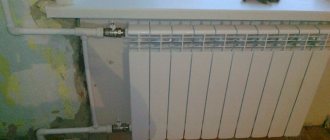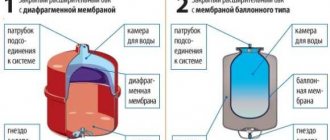Home / Gas boilers
Back
Published: 05/14/2019
Reading time: 3 min
0
16154
As a result of an increase in pressure on the boiler above the nominal value, periodic blocking occurs, and excess coolant is released from the safety valve.
The heating system is not designed to operate in a mode where all its components are under excessive load. Overloads can lead to negative consequences due to the failure of expensive elements.
Therefore, the reason why pressure increases in a double-circuit boiler must be eliminated immediately. For users of an autonomous heating system, a list of probable malfunctions that can lead to increased pressure and ways to eliminate them is presented.
- 1 Why you need to monitor the pressure in the boiler
- 2 Reasons for increased pressure in case of boiler damage
- 3 Why does the pressure rise in the heating boiler 3.1 Air lock in the system
- 3.2 Malfunctions of the expansion tank
- 3.3 Other causes of increased pressure
Pressure increase due to expansion tank
What is the reason and what can be done if the pressure gauge shows high pressure?
The problem may lie in the expansion tank.
- Membrane damage. When heated to the maximum set temperature in the heating system, the liquid increases in volume by approximately 4%. This excess volume enters the expansion device, compensating for the pressure in the system.
If the membrane is damaged, the liquid will completely fill the volume and initially the pressure in the system will drop. When you open the make-up tap and add water to the system as the temperature increases, the pressure will become higher than rated.How to determine that the membrane is damaged - when pumping air, the pressure drops, excess liquid comes out through the hoses that connect to the system. A new tank is needed.
- Too small a volume of the expansion device causes the pressure to rise quickly as the temperature rises. The size of the compensation tank depends on the power of the heat generator, provided that standard radiators are connected. But, if you use pipes instead of radiators, the amount of coolant will be greater, in this case the pressure will be maintained at a constantly high level.
- The discrepancy between the pressure in the compensation tank and the nominal one is also the reason why the pressure increased. You can pump it up using a car pump with a pressure gauge, after draining the liquid from the boiler and turning off the supply and return taps.
Pump the pump until you see that the water is not flowing. Then you need to bleed the air and pump it up again to the value specified in the boiler manual. Unfortunately, not all manufacturers indicate the pressure of the expansion tank of their products in the instructions; for example, it is not indicated in the instructions for the Immergaz heat generator.
- Water hammer causes high pressure in a gas boiler, what to do in this case?
In some double-circuit boilers, the compensation tank is located immediately after the circulation pump; when it is turned on, the pressure rises sharply, then also drops sharply. How can you reduce the influence of the pump and remove excess pressure - the expansion tank is mounted on the return pipe, and the pump is installed in series after the tank, in front of the boiler.
The working pressure of the compensation tank of some 24 kW models is shown in the table.
Pressure in the heating system, its normalization, reasons for the change
The pressure in the heating system should be normal - 1.5 - 2.0 atmospheres for private houses with a height of up to 2 floors. If the pressure differs from the specified limits, the system must be “treated”.
In this article we will analyze the nuances of the heating system and boiler room equipment. Let's decide what pressure needs to be maintained, how to set it, what it depends on... Probably the given material will help readers in matters related to the performance of the heating system and the use of equipment.
What pressure should be in the heating system
In low-rise private houses, the operating pressure of the heating system is about 2 atmospheres. More often 1.5 – 2.0 atmospheres. The maximum pressure rise is allowed up to 3 atmospheres, and above that the emergency valve must be activated.
In high-rise buildings, the normal pressure ranges from 5 to 10 atm. More often – 5 – 8 atm. The maximum that heating radiators in apartments in high-rise buildings are designed for is 12 atm.
The same pressure - 12 atm - can also be found in the main pipes of heating networks.
In high-rise buildings, hydraulic reducers are installed on heating risers to reduce pressure.
Why does blood pressure rise?
According to the laws of physics, when a liquid or gas is heated, its volume increases. Therefore, if the liquid is in a closed heating system, then its pressure will increase with increasing temperature.
A liquid cannot be significantly compressed like a gas. If the space is closed, then a large pressure surge may occur and the shell will rupture.
In the “wrong” closed-type heating system, this is what happens - the weakest link, for example, the boiler heat exchanger, is destroyed, and the liquid finds its way out.
In open heating systems - with gravity movement of liquid (in which the expansion tank is open), the pressure does not increase during heating. It is set there by the height of the water column - usually 1 - 2 floors - respectively, up to 1, and the liquid simply goes into the tank or runs down the drain. But in closed systems other special equipment is used.
How to normalize the situation
To prevent a dangerous increase in pressure when heating the coolant, closed systems (with forced circulation of liquid) include the following mandatory elements:
- An expansion tank is a closed vessel partially filled with air, which is capable of significantly compressing when pressure increases, freeing up volume for an “incompressible” liquid.
- A safety valve is a device that opens the release of liquid from the system if the pressure in it has reached the set maximum pressure - usually 3 atm.
- A pressure gauge is a device that measures and indicates the pressure of a liquid or gas. Its readings are also used when filling, pumping up the system, monitoring operation...
The same equipment should be installed on the hot water supply system in private houses, which includes an indirect heating boiler.
Safety group for a heating system with a manual boiler - safety valve, air vent, pressure gauge. In wall-mounted boilers, these devices are built-in.
Read more on the website - how to properly wire a non-automated boiler
What is the volume of the expansion tank?
It is unacceptable to use an expansion tank of a smaller volume than 1/10 of the entire heating system. However, for a professional calculation of the volume of the expansion tank there is a special technique. But at the household level it is decided this way - no less than 1:10 of the coolant poured into the heating system. Then the expansion tank can compensate for the increase in liquid volume from its heating without problems.
How to find out how much coolant is in the system? All that remains is to arm yourself with geometric formulas and reference data on the equipment used. But in practice, when creating heating with your own hands, without a project, the volume is simply calculated in buckets during the initial filling. After which they purchase a suitable expansion tank.
Operating principle of the expansion tank
Why does the pressure in the heating system decrease?
The pressure in the heating system constantly decreases from the initial set value. This decrease can be very small and not noticeable on instruments (pressure gauges). Or it may drop significantly.
A large decrease in pressure can occur for two reasons:
- After filling the liquid, there is air in the heating system. It will gradually be released through automatic air vents (must be present). The decrease in pressure must be compensated by adding new coolant.
- There is a leak in the heating system and the coolant is leaving. But there may also be an air leak from a closed expansion tank.
It is not allowed to automatically refill the heating system with water when the pressure decreases. If there is a leak, the water in the system will be constantly renewed, which will lead to significant sediment and failure of the entire system.
How to find a leak in a heating system
Typically, coolant leaks occur at joints due to poor-quality installation. It is enough to carefully inspect the system and pay attention to streaks and red marks (sediment from the water). Repair based on “diagnosis”.
But sometimes it is difficult to detect visually. Then they search by ear - the system is drained and filled with air under pressure. A characteristic whistle will indicate where the “hole” is located.
You can also use special equipment - an excess humidity scanner.
We must not forget about the boiler. The presence of a leak in the heat exchanger, through small cracks, is not a rare occurrence. It will not be possible to detect it “on the fly” - the coolant immediately evaporates and leaves along with the gases. Checked with the boiler stopped.
It is not advisable to locate the junction points in places inaccessible for inspection and repair. Check out - The problem of installing polypropylene pipelines - how to solder the pipes correctly.
How to set the pressure in the heating system
The initial pressure in the heating system is set by pumping the expansion tank with air when the coolant is cold. The expansion tank is filled with air until a pressure of 1.3 - 1.5 atm is created. Accordingly, when heated, if the volume of the tank is selected correctly, the pressure can reach – 2.0 atm.
The expansion tank is equipped with a regular air valve, just like on a car, and can be inflated by a car pump or compressor.
We examined the main issues related to pressure in the heating system for a private home. It is also recommended to familiarize yourself with How the hydraulic accumulator and expansion tank work
Pressure in closed heating systems
With the help of a circulation pump, dynamic pressure is created in the heating system.
Thanks to this, a closed system has the following advantages:
- the length of the heating circuit increases in direct proportion to the pump power;
- batteries can be connected both in series and in parallel; with a parallel connection, the heat is distributed more evenly;
- possibility of installing small diameter pipes;
- gas savings, since the coolant has a higher speed than in open systems, it does not cool down as much;
- to relieve excess pressure, you can reduce the power of the circulation pump;
- the ability to select pump power to overcome hydraulic pressure and depending on the length of the circuit and the diameter of the pipes.
Air lock as a cause of increased pressure
Another possible reason why the pressure itself increases is the presence of air in the heating circuit.
Airing can occur due to:
- when the heating circuit fills with liquid too quickly, the system should be filled slowly, with the air bleed valves open. The valves are open until liquid flows from the highest point of the system;
- Mayevsky's taps are broken, change the taps;
- The impeller of the circulation pump is loose, which may allow air to enter, adjust the impeller.
Other problems
In addition to the above reasons, there are other moments when the pressure in the heat generator rises above normal:
- Closed or insufficiently open shut-off valves. The pressure on the supply flow increases, the unit is blocked. In order to reduce the pressure, open the valves all the way, check if the shut-off valves are leaking.
- The dirt filter is dirty. Washing the filter will help reduce the pressure; if it is in very poor condition, replace it with a new one.
- The water supply tap is malfunctioning when water drips from it. Liquid from the water main, where the pressure is about 2.5-3.5 Bar, flows into the heating circuit, where the pressure is less.
Make-up valve in the heating system
As a result, the pressure in the heating circuit increases. In order to reduce it, replace the tap, but most often the gasket needs to be replaced; it wears out quickly, especially if the water is very hard.
- The automation is faulty, the thermostat or controller is faulty. The reasons may be different; only a specialist can determine the specific one. You can fix it yourself if a specific error is displayed and the way to fix it is described in the instructions.
- Formation of a fistula in the heat exchanger. In this case, water for hot water supply, which has greater pressure, enters the heating circuit through the fistula, increasing its pressure. Soldering the heat exchanger is not always possible; replacement is the solution.
High pressure in a gas boiler - what to do to lower it
What is the reason and what can be done if the pressure gauge shows high pressure?
The problem may lie in the expansion tank.
- Membrane damage. When heated to the maximum set temperature in the heating system, the liquid increases in volume by approximately 4%. This excess volume enters the expansion device, compensating for the pressure in the system.
If the membrane is damaged, the liquid will completely fill the volume and initially the pressure in the system will drop. When you open the make-up tap and add water to the system as the temperature increases, the pressure will become higher than rated.How to determine that the membrane is damaged - when pumping air, the pressure drops, excess liquid comes out through the hoses that connect to the system. A new tank is needed.
- Too small a volume of the expansion device causes the pressure to rise quickly as the temperature rises. The size of the compensation tank depends on the power of the heat generator, provided that standard radiators are connected. But, if you use pipes instead of radiators, the amount of coolant will be greater, in this case the pressure will be maintained at a constantly high level.
- The discrepancy between the pressure in the compensation tank and the nominal one is also the reason why the pressure increased. You can pump it up using a car pump with a pressure gauge, after draining the liquid from the boiler and turning off the supply and return taps.
Pump the pump until you see that the water is not flowing. Then you need to bleed the air and pump it up again to the value specified in the boiler manual.Unfortunately, not all manufacturers indicate the pressure of the expansion tank of their products in the instructions; for example, it is not indicated in the instructions for the Immergaz heat generator.
- Water hammer causes high pressure in a gas boiler, what to do in this case?
In some double-circuit boilers, the compensation tank is located immediately after the circulation pump; when it is turned on, the pressure rises sharply, then also drops sharply. How can you reduce the influence of the pump and remove excess pressure - the expansion tank is mounted on the return pipe, and the pump is installed in series after the tank, in front of the boiler.
The working pressure of the compensation tank of some 24 kW models is shown in the table.
Pressure in closed heating systems
With the help of a circulation pump, dynamic pressure is created in the heating system.
Thanks to this, a closed system has the following advantages:
- the length of the heating circuit increases in direct proportion to the pump power;
- batteries can be connected both in series and in parallel; with a parallel connection, the heat is distributed more evenly;
- possibility of installing small diameter pipes;
- gas savings, since the coolant has a higher speed than in open systems, it does not cool down as much;
- to relieve excess pressure, you can reduce the power of the circulation pump;
- the ability to select pump power to overcome hydraulic pressure and depending on the length of the circuit and the diameter of the pipes.
Air lock as a cause of increased pressure
Another possible reason why the pressure itself increases is the presence of air in the heating circuit.
Airing can occur due to:
- when the heating circuit fills with liquid too quickly, the system should be filled slowly, with the air bleed valves open. The valves are open until liquid flows from the highest point of the system;
- Mayevsky's taps are broken, change the taps;
- The impeller of the circulation pump is loose, which may allow air to enter, adjust the impeller.
Other problems
In addition to the above reasons, there are other moments when the pressure in the heat generator rises above normal:
- Closed or insufficiently open shut-off valves. The pressure on the supply flow increases, the unit is blocked. In order to reduce the pressure, open the valves all the way, check if the shut-off valves are leaking.
- The dirt filter is dirty. Washing the filter will help reduce the pressure; if it is in very poor condition, replace it with a new one.
- The water supply tap is malfunctioning when water drips from it. Liquid from the water main, where the pressure is about 2.5-3.5 Bar, flows into the heating circuit, where the pressure is less.
Make-up valve in the heating system
As a result, the pressure in the heating circuit increases. In order to reduce it, replace the tap, but most often the gasket needs to be replaced; it wears out quickly, especially if the water is very hard.
- The automation is faulty, the thermostat or controller is faulty. The reasons may be different; only a specialist can determine the specific one. You can fix it yourself if a specific error is displayed and the way to fix it is described in the instructions.
- Formation of a fistula in the heat exchanger. In this case, water for hot water supply, which has greater pressure, enters the heating circuit through the fistula, increasing its pressure. Soldering the heat exchanger is not always possible; replacement is the solution.
Preventative work
Make sure that the pressure gauge, air vent and safety valve are in good working order; these devices serve to protect your unit from high pressure.
Safety group for heating system
Adding antifreeze to the coolant in models where this is not prohibited by the manufacturer will reduce filter clogging, sticking of safety valve elements, and reduce the formation of scale on air vents.
Rinse the heat exchanger regularly, this will extend its service life and prevent the formation of fistulas and scale.
We invite you to watch a video with answers to questions about increasing pressure in the heating system:
Source: https://boilervdom.ru/kotly/problemy/vysokoe-davlenie-v-gazovom-kotle-chto-delat-chtoby-ego-ponizit.html
Preventative work
Make sure that the pressure gauge, air vent and safety valve are in good working order; these devices serve to protect your unit from high pressure.
Safety group for heating system
Adding antifreeze to the coolant in models where this is not prohibited by the manufacturer will reduce filter clogging, sticking of safety valve elements, and reduce the formation of scale on air vents.
Rinse the heat exchanger regularly, this will extend its service life and prevent the formation of fistulas and scale.
We invite you to watch a video with answers to questions about increasing pressure in the heating system:
The pressure in the boiler increases
When the pressure in a double-circuit gas boiler drops, this is somehow understandable, but when the pressure itself increases! What could it be? However, this is exactly what I had to face one day. This was discovered thanks to a safety relief valve. He began to release the pressure by spitting water from the boiler. The pressure gauge showed a pressure exceeding 3 bar.
First of all, I relieved the pressure in the heating system through the Mayevsky valve, and began to observe the readings of the pressure gauge; the pressure was slowly but surely growing. My first thought was that the water supply valve began to leak, tightened it, nothing changed. Then I took out the boiler maintenance manual (the manual is available) and began looking at the hydraulic diagram, and quite quickly realized that the reason was in the secondary heat exchanger.
So there are two reasons why the pressure in the boiler can gradually but constantly increase:
- The water supply valve does not hold.
- The secondary heat exchanger is faulty.
